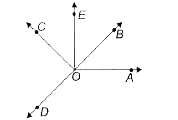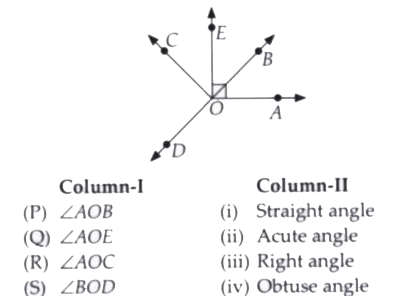Study the given figure carefully and match the following.

Column 1Column II(a)∠AOB(i) Straight angle(b)∠AOE(ii) Acute angle(c)∠AOC(iii) Right angle(d)∠BOD(iv) Obtuse angle
(a)→(i),(b)→(iv),(c)→(ii),(d)→(iii)
(a)→(ii),(b)→(i),(c)→(iii),(d)→(iv)
(a)→(ii),(b)→(iii),(c)→(iv),(d)→(i)
(a)→(i),(b)→(ii),(c)→(iii),(d)→(iv)
The correct Answer is:C
Step by step video & image solution for Study the given figure carefully and match the following. {:("Column 1","Column II"),((a) angleAOB ,"(i) Straight angle"),((b) angleAOE ,"(ii) Acute angle"),( (c) angleAOC,"(iii) Right angle"),((d) angleBOD,"(iv) Obtuse angle"):} by Maths experts to help you in doubts & scoring excellent marks in Class 6 exams.
Topper's Solved these Questions
- BOOK - SCIENCE OLYMPIAD FOUNDATION CHAPTER - UNDERSTANDING ELEMENTARY SHAPESEXERCISE - ACHIEVERS SECTION (HOTS)5videos
UNDERSTANDING ELEMENTARY SHAPES
- BOOK - SCIENCE OLYMPIAD FOUNDATION CHAPTER - SYMMETRYEXERCISE - MATHEMATICAL REASONING15videos
SYMMETRY
- BOOK - SCIENCE OLYMPIAD FOUNDATION CHAPTER - WHOLE NUMBERSEXERCISE - Achievers section (HOTS)5videos
WHOLE NUMBERS
Similar Questions
Study the given figure carefully. If DOB is a straight line, then match the columns.

Column - IColumn - II(P)∠AOB(i)Straight angle(Q)∠AOE(ii)Acute angle(R)∠AOC(iii)Right angle(S)∠BOD(iv)Obtuse angleView SolutionMatch Column I with column II
Column IColumn II(a)Bilirubin and biliverdin(i)Parotid(b)Hydrolysis of starch(ii)Bile(c)Digestion of fat(iii)Lipases(d)Salivary gland(iv)AmylasesView Solution
Knowledge Check
- Question 1 - Select One
Match the column I and II
Column IColumn II(a) Apocarpous(i) Papaver(b) Syncarpous(ii) Michellia(c) Epiphyllous(iii) Cashew(d) Cotyledon(iv) AloeAa – i, b–ii, c–iii, d –ivBa – ii, b–i, c–iv, d –iiiCa – iv, b–iii, c–ii, d –iDa – iv, b–i, c–iii, d –ii - Question 2 - Select One
Match the column I with column II
Column IColumn II(A) Thylacine (i) Russia (B) Dodo (ii) Mauritius (c ) Quagga(iii) Australia (D) Steller's sca cow (iv) AfricaAa (ii), b (iii), c (i), d(iv)Ba(iv), b(i), c(ii), d(iii)Ca(iii), b(iv), c(ii), d(i)Da(iii), b(ii), c(iv), d(i) - Question 3 - Select One
Match the column I and II
Column IColumn II(i) Chrysophyte(a) Gonyaulax(ii) Dinoflagellate(b) Euglena(iii) Euglenoids(c) Diatom(iv) Slime moulds(d) PlasmodiumAi – a, ii – c, iii – b, iv – dBi – a, ii – d, iii – b, iv – cCi – c, ii – b, iii – d, iv – aDi – c, ii – a, iii – b, iv – d
Match the column I with Column II:-
Column IColumn II(A) Unicellular(i) Spirogyra(B) Colonial(ii) Kelps(C) Filamentous(iii) Volvox(D) massive plant bodies(iv) ChlamydomonasView SolutionAn angle of measure 1400 is (a)an acute angle (b) an obtuse angle (c)a straight angle (d) a complete angle
View SolutionGive two measures of (i) acute angle (ii) obtuse angle.
View SolutionMatch the following columns
Column IColumn IIa.Lysozyme(i)HClb.Peptic cells(ii)Antibacterial enzymec.Saliva(iii)Sublingual glandd.Oxyntic cells(iv)PepsinogenView SolutionMatch the compounds given in Column I with the hybridisation and shape given in Column II and mark the correct option.
Column IColumn II(A)XeF6(1)sp3d3−distorted octahedral(B)XeO3(2)sp3d2−square planar(C)XeOF4(3)sp3−pyramidal(D)XeF4(4)sp3d2−square pyramidalView Solution

